
Upgrading to Lead Acid Forklift Batteries
Upgrading to Lead Acid Forklift Batteries
Forklifts are an indispensable part of forklift batteries material handling in warehouses, factories, and distribution centers. As businesses strive for efficiency and sustainability, the type of forklift batteries they choose can significantly impact operations. Among various options available in the market, lead acid forklift batteries have been a long-standing choice 12 volt flat plate forklift batteries for many. This article delves into the reasons behind upgrading to lead acid forklift batteries, their advantages, potential drawbacks, and considerations when switching from other battery types.
Understanding Forklift Battery Technology
Forklift batteries play a crucial role in powering electric forklifts. There are primarily two types of batteries used: lead acid and lithium-ion. Understanding how these technologies work is essential for making an informed decision about upgrading.
How Lead Acid Batteries Work
Lead acid batteries operate by converting chemical energy into electrical energy through electrochemical reactions. They consist of lead dioxide (PbO2) as the positive plate, sponge lead (Pb) as the negative plate, and sulfuric acid (H2SO4) as the electrolyte. When the battery discharges, lead sulfate is formed on both plates.
The Chemistry Behind Lithium-Ion Batteries
Lithium-ion batteries utilize lithium ions moving from the negative electrode to the positive electrode during discharge. They are known for their high energy density but come with their own set of challenges such as cost and safety concerns.
Why Upgrade to Lead Acid Forklift Batteries?
When considering an upgrade to lead acid forklift batteries, several factors come into play. Here’s a closer look at why many companies opt for this technology.
Cost-Effectiveness
One of the most compelling reasons businesses consider upgrading is cost-effectiveness. Lead acid batteries typically have a lower initial purchase price compared to lithium-ion counterparts.
Proven Technology
Lead acid technology has been around since the 1850s and has proven itself in various applications over time. This reliability fosters trust among businesses looking to invest in dependable solutions.
Performance Characteristics of Lead Acid Forklift Batteries
Performance is key when it comes to forklift operations; thus understanding how lead acid batteries perform becomes vital.
Cycle Life and Depth of Discharge
Cycle life refers to how many cycles a battery can undergo before its capacity diminishes significantly.
- Typical Cycle Life: A well-maintained lead acid forklift battery can last between 1,500 and 2,000 cycles.
- Depth of Discharge (DoD): Operating within recommended DoD limits can extend battery life considerably.
Operational Efficiency
The efficiency at which a battery releases its stored energy impacts overall performance:
Environmental Considerations: Why Choose Lead Acid?
With increasing focus on sustainability and environmental responsibility, choosing the right type of battery is critical for any business aiming for eco-friendliness.
Recyclability of Lead Acid Batteries
Lead acid batteries are one of the most recycled products globally:
- Approximately 97% of materials are recoverable.
- Recycling contributes to reducing landfill waste and conserving resources.
Lower Carbon Footprint
In terms of production emissions:
- Lead-acid manufacturing processes generate fewer greenhouse gases compared to lithium ion.
- Opting for recycled materials further reduces carbon output associated with new battery production.
Challenges Associated with Lead Acid Forklift Batteries
While there are numerous benefits associated with upgrading to lead acid forklift batteries, it’s important also to understand potential challenges that may arise.
Maintenance Requirements
Proper maintenance is essential for maximizing battery lifespan:
Weight Considerations
Lead-acid batteries tend to be heavier than other types like lithium-ion:
- Heavier weight can impact overall vehicle maneuverability.
- This may necessitate adjustments depending on operational needs or warehouse layout considerations.
Key Factors When Upgrading Your Battery System
When contemplating an upgrade, several practical aspects require attention:
Compatibility with Existing Equipment
Before making any changes:
Assessing Energy Needs Wisely
Understanding specific energy needs assists in selecting appropriate capacity levels:
Comparative Analysis: Lead Acid vs Lithium-Ion Forklift Batteries
To better appreciate why companies might lean toward upgrading specifically towards lead-acid technology rather than others like lithium-ion requires comparative analysis across several dimensions:
| Feature | Lead Acid | Lithium-Ion | |----------------------|------------------------|-----------------------| | Initial Cost | Lower | Higher | | Cycle Life | 1500 - 2000 cycles | 3000 - 5000 cycles | | Maintenance | Moderate | Low | | Weight | Heavier | Lighter | | Environmental Impact | High recyclability | Limited recyclability |
Installation Process Overview for Lead Acid Forklift Batteries
Upgrading involves not just purchasing but also effectively installing your new systems; here’s how it generally unfolds:
Step-by-Step Installation Guide
FAQs About Upgrading to Lead Acid Forklift Batteries
Q1: How long do lead-acid forklift batteries typically last? A1: With proper maintenance practices adhered too diligently including regular watering procedures plus avoiding deep discharges during operation cycles; expect upwards towards 5 years lifespan!
Q2: Are there any safety concerns I should be aware of? A2: Yes! When handling these robust units always wear protective gear including gloves & goggles due potential 18 volt flat plate forklift batteries exposure risks 72 volt flat plate forklift batteries associated with sulfuric acids present inside their cells—never forget those safety protocols!
Q3: What kind of maintenance do these types require? A3: Regular watering & terminal cleaning along with periodic equalization charges will keep your unit running optimally—don’t underestimate this vital aspect!
Q4: Can I use my existing charger? A4: Generally speaking yes! However double-check compatibility specifications prior usage especially if transitioning from different chemistry models—better safe than sorry!
Q5: Will upgrading affect my operational costs positively? A5: Absolutely! Lower upfront investment combined with high recyclability makes them very attractive financially when weighed against alternatives such as lithium-ion options over timeframes considered.
Conclusion
Upgrading to lead acid forklift batteries offers numerous advantages including cost savings, reliability, ease-of-recycling opportunities alongside established performance metrics covering longevity & operational robustness—all pivotal elements aiding efficiency improvements across diverse industrial settings! By weighing both pros & cons thoroughly beforehand while implementing best practices diligently thereafter; organizations stand poised reap significant returns from this powerful technological transition journey ahead!
